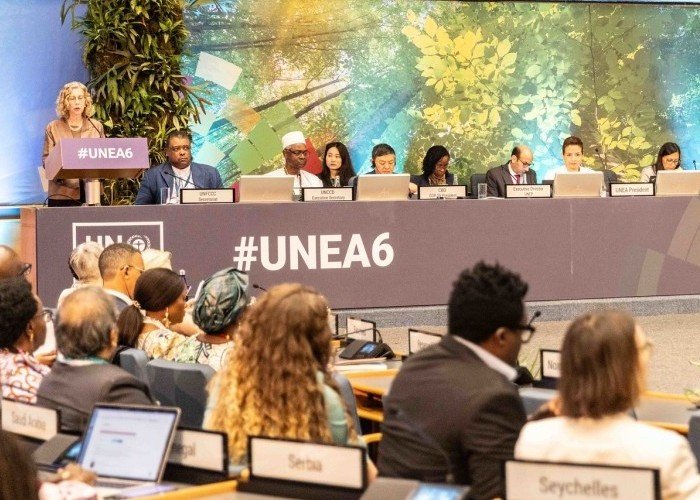NASEM Recommends a Federal Research Program on Climate Intervention: What does it mean?
Source: Christopher Michel
By Kelly Wanser, Executive Director, SilverLining, and Alex Wong, Research Director, SilverLining
In our escalating climate emergency, research on approaches that influence natural processes to rapidly reduce greenhouse gases or warming in the atmosphere (sometimes called "climate intervention" or "geoengineering") has become more important, perhaps critically so. Climate impacts, already catastrophic to many communities, are projected to increase in the next 30-40 years, a period in which no amount of emissions reductions can significantly affect warming. (1)
The impacts of climate change disproportionately affect the most vulnerable in society, making research on options to improve their near-term safety critical for climate justice. As impacts grow, climate intervention research and weather modification activities—such as cloud seeding programs in China—are also growing around the world, making them important areas of international cooperation and global security.
SilverLining is a longtime advocate for research on near-term climate risks and interventions to protect people and natural systems while society transitions to a sustainable future. For the past several years, we have been a driving force behind efforts to launch a U.S. National Academies of Sciences, Engineering, and Medicine (NASEM) study to develop an agenda and governance for research on climate interventions that increase the reflection of sunlight from the atmosphere to cool climate, or "solar climate intervention" (SCI). The NASEM recently published this report, which recommended a robust, interdisciplinary, multi-agency research program for the United States, alongside cooperative international efforts.
A great deal of research is needed to equip policymakers, stakeholders, and society with the ability to assess the risks and benefits of SCI. The NASEM report takes an important step forward by outlining a framework to pursue this research in the U.S., which historically has been the leading provider of climate and weather data, models, and scientific support to the rest of the world.
SilverLining strongly endorses the two main recommendations of the NASEM report:
The urgency of climate change requires a full scientific understanding of possible options to respond. Therefore, the U.S. should establish an interdisciplinary, multi-agency research program on solar climate intervention (geoengineering).
The U.S. Global Change Research Program (USGCRP) should be the entity responsible for coordinating research across federal agencies and with research outside the United States, as part of an overall mission to advance understanding of effective options for managing urgent climate change risks from local to international scales.
Climate projections currently include catastrophic effects on people and ecosystems that are not addressed by the existing portfolio of options to slow warming. The U.S. leads the world in the scientific and technological capabilities required to explore and assess additional options. The recommendation to establish a broad, ambitious, and responsible research program in the U.S. is both groundbreaking and crucial. Such a program offers the potential to provide the world with open information and tools to support objective, science-based evaluation, dialogue, and decision-making about possibilities with unusual promise for near-term protection, as well uncertain and potentially unacceptable risks.
This research will be most successful if it is well-coordinated. In the U.S., there are 13 agencies with a significant role in climate research, which since 1990 have coordinated their efforts under the USGCRP (you may know it as the body that produces the U.S. National Climate Assessment). For years, SilverLining has recommended that U.S. federal agencies work together to research climate interventions, and we endorse the recommendation to coordinate their efforts through the successful structure of the USGCRP.
The NASEM recommends that the USGCRP-coordinated solar climate intervention research program include research in three areas:
Context and goals for climate intervention research, developing a research agenda to explore future conditions and uncertainties that will affect decision-making, designing strategies to maximize the prospects for broadly beneficial outcomes and building capacity for exploration of these topics by stakeholders around the world.
Impacts and technical dimensions, research and development in areas such as properties of reflective particles and their interactions with atmospheric processes, climate impacts and ecological and human systems outcomes, and monitoring and other technologies for observing the earth system.
Social dimensions, including equity, effective governance, ethical considerations, public perceptions and engagement, and the dynamics of international cooperation.
We endorse these areas of emphasis. SCI research is applied research aimed at understanding potential real-world outcomes against a time-sensitive problem in a highly complex system. It requires a mission-oriented research agenda that spans physical sciences technology and human dimensions.
However, SCI approaches are just one potential element of a broader portfolio of responses to climate change. Evaluating and developing this portfolio requires a national research effort aimed at assessing interventions including, but not limited to, SCI, and understanding the possibilities and limitations among mitigation, adaptation, and interventions to manage climate risk.
The NASEM report on reflecting sunlight followed a separate NASEM report on the future direction for the USGCRP. That report recommended realigning U.S. climate research efforts to focus on managing climate risk in service of the security and well-being of Americans and with concern for equity and justice. Climate interventions sit within a broader context for climate risk management, and it will be important to synthesize these efforts. We believe that an interagency research program (such as the USGCRP) that includes SCI should also include near-term climate risk management and research and assessment of other interventions that leverage earth system processes (e.g., ocean fertilization, afforestation) to reduce greenhouse gases and warming.
The NASEM report recommends $100-200 million in funding over five years to study topics related to three prominent approaches to increasing the reflection of sunlight in the atmosphere: stratospheric aerosol injection (SAI), marine cloud brightening (MCB), and cirrus cloud thinning (CCT).
We applaud the NASEM committee for recommending a robust level of funding for research. Is that amount enough to understand the feasibility and risks of these approaches in 5 years? No, but it is a healthy start. A concerted study of the materials, processes, and specific earth system responses for even narrowly defined SCI scope of research is likely to require more funding. In the near-term, philanthropy may play an important role in supporting early critical work, as we have seen in the efforts of SilverLining’s Safe Climate Research Initiative (SCRI).
The natural system processes underlying SCI approaches are central aspects of climate and atmosphere, specifically the effects of particles (aerosols) on clouds, climate, and atmospheric chemistry. Understanding SCI approaches is intimately tied to important areas of climate and atmospheric science and also requires investment in climate models, observations, and basic science.
SilverLining was an early advocate for U.S. federal funding for basic science related to SCI. We helped advance funding to the National Oceanic and Atmospheric Administration (NOAA) for research in understanding the effects of aerosols from various sources (natural, industrial, and interventional) on Earth's reflectivity, climate, and the chemistry of the stratosphere. Similarly, we have helped advance funding in the U.S. Department of Energy for cloud-aerosol research and related climate modeling, with applications for understanding weather, climate risks, and climate interventions. Much more is needed for each of the relevant agencies in the U.S. to pursue related efforts such as understanding the natural system, the influence of industrial emissions on atmospheric sunlight reflection and climate, and SCI.
The total U.S. budget for climate research is approximately $2.6 billion annually—a small fraction of the cost of one climate-linked extreme fire or powerful storm. Furthermore, the climate research budget has been relatively flat for decades. When the climate was changing slowly and therefore more predictably, this may have made sense, but we have entered a phase where even small improvements in understanding and predicting climate are immensely valuable. With respect to SCI, major investment in climate models, observations, and scientific research is imperative to understand and weigh the dangers of warming with the risks of intervention.
The NASEM report recommends small-scale outdoor release experiments to provide "information that is qualitatively different from that of existing modes of research."
The NASEM study describes the role of small-scale experiments that release relevant materials as providing information on small-scale processes that is essential to modeling effects that would occur at larger scales. Small-scale experiments provide information that cannot be gained in any other way and help avoid experiments at larger scales. These experiments are often of concern and can be misunderstood, and it is important to ensure they are governed in the interests of society. Small-scale atmospheric release experiments are also not new—they sit within a framework of existing laws, regulations, and federal science processes. As with the research program itself, governance for SCI experiments and other research requires integration with related areas of science. The good news is that robust mechanisms for scientific review, environmental and public safety, and public engagement exist in these areas, and a federal research program is itself a major step forward in governance.
The NASEM report states that climate intervention research should promote international cooperation, especially with stakeholders from the Global South. The report highlights the work of the Developing Country Impacts Modelling Analysis for Solar Radiation Management (DECIMALS) fund as an example of Global South research that should receive increased investment.
We wholeheartedly endorse the recommendation to promote international cooperation in SCI research and the emphasis on stakeholders from the Global South. SilverLining published a series of papers by leading international climate law experts on the role of research and scientific cooperation in effective international decision-making. SilverLining is also proud to support SRMGI DECIMALS program (part of the Solar Radiation Management Governance Initiative), which sponsors researchers in the Global South—encompassing areas of the world that often experience the greatest impacts of climate change—to study the benefits and risks of SCI for their regions.
Addressing near-term climate risk is a profoundly important part of an effective overall climate strategy for both the U.S. and the world. The Biden-Harris administration has committed to prioritizing climate issues, making climate a part of all areas of government policy and placing climate research first in the list of priorities for federal research investment. As the administration pursues efforts to decarbonize and increase investment in climate-centric policy, the SCI research agenda proposed by the National Academies of Sciences, Engineering, and Medicine will complement its efforts, arming policymakers with the scientific knowledge necessary to make informed decisions on these potential near-term options for ensuring a safe climate.
—
(1) Samset, B. H. … Lund, M. T. (2020). Delayed emergence of a global temperature response after emission mitigation. Nature Communications, 11(1), 3261. https://doi.org/10.1038/s41467-020-17001-1




